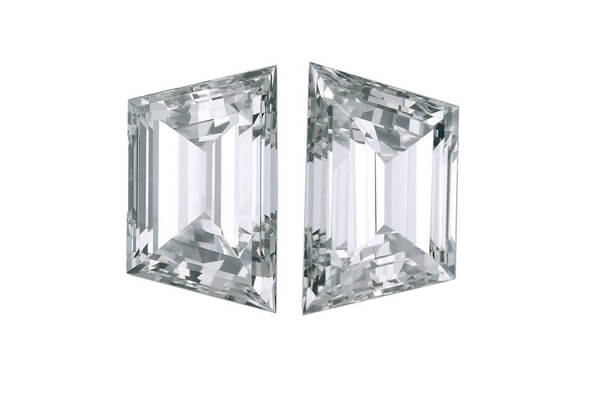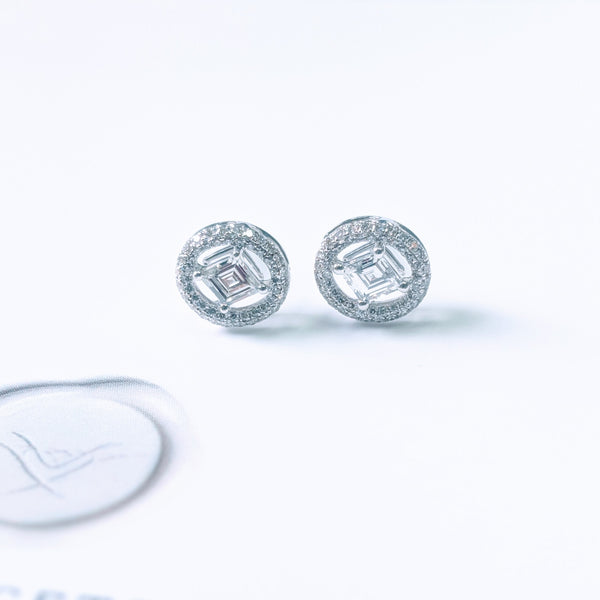STEP-CUT DIAMONDS
Our uplifting Serendipity Collection features a few playful, handcrafted step-cut diamond earrings, each piece radiating an understated sparkle. Discover the refined intricacies of this unique diamond cut.
Subtly bright and elegant, step-cut diamonds are delicate rectangular or square stones with their facets sitting parallel to each other, creating a sophisticated and geometric look.
The upper and bottom-most facets of step-cut diamonds, also known as tables and culets, respectively, are broad while the other facets on the diamond are narrower. This characteristic allows the beholder to see inside the diamond, which appears more transparent than brilliant-cut diamonds.

Image courtesy of Cape Diamonds
The main difference between brilliant-cut and step-cut diamonds is how powerful the sparkle of the stone is. While step-cut diamonds have a subtle glow, brilliant cuts, typically princess-cut or round-cut diamonds, shine brighter because they have more triangular and kite-shaped facets.
The most popular step-cut diamond shapes are baguette, emerald and Asscher, as can be seen hereunder.

Image Courtesy of Kobelli
BAGUETTE-CUT DIAMONDS

Baguette-Cut Diamond Pair | Image Courtesy if C Diamond Group
Baguette diamonds are famous for their rectangular shape and pronounced edges. This diamond cut gets its name from the French word baguette, accurately representing its thin, step-cut design. Older versions of baguette-cut diamonds have been prevalent in jewelry since the 1550s.
These beautiful diamonds are rarely set alone in jewelry. They are paired with either other refined diamond cuts or more baguette diamonds to add a variety of visual effects as they reflect light in a unique, hologram-like way. Baguette-cut diamonds are also commonly used as either elegant side or surrounding stones while highlighting a stunning, centrally mounted stone.

64Facets Bespoke Engagement Ring with Two Baguette Diamonds as Side Stones
When baguettes are the main diamonds on a fine piece of jewelry, designs can be created by using multiple stones, including baguette cuts of the same or various lengths. These unique jewelry styles can be used to form initials, create a checkerboard pattern or line diamonds up side by side.
EMERALD-CUT DIAMONDS

Emerald-Cut Diamond Engagement Ring | Image courtesy of Ring Concierge
Emerald-cut diamonds are the most popular step-cut diamonds because of their regal appearance, as they are loved by royals and celebrities alike. This diamond cut has long, rectangular facets creating a flash known as the "hall of mirrors" effect. An emerald-cut diamond is a rectangle with eight sides, prominent table and culet facets with the corners of the diamond clipped, resulting in tiny, delicate edges.
This diamond cut gets its name from the revitalizing and mature emerald. The symbolic verdant gemstone is typically cut as a rectangle with cropped corners to reduce the risk of damage and showcase its remarkable internal characteristics.
Emerald-cut stones are eminent for their exceptional color, luster and clarity, which is why they are commonly used as a central stone in pendants, earrings, diamond engagement rings, and other fine jewelry pieces.
ASSCHER-CUT DIAMONDS

Asscher-Cut Diamond | Image Courtesy of DC Jewellery
The Asscher cut is a sophisticated, square-shaped diamond cut with X-shaped facets running from its corners to its center culet, creating a truly mesmerizing sparkle. Asscher-cut diamonds get their name from the Royal Asscher Diamond Company, a jewel firm from the Netherlands. In order to retain carat weight, the Asscher Cut, considered to be the older cut, was created in 1902 with the diamond having 58 facets. Other jewelers were allowed to use this cut after its patent expired in the 1940s.
In 1999, the Royal Asscher Cut first debuted. This cut was designed as both a tribute and an improvement to the original Asscher Cut. The newer design exhibited eight additional facets to both halves of the diamond, adding more brilliance to the step-cut stone. Its facets are also narrower than the original cut.
Asscher diamonds often resemble princess-cut diamonds from afar due to their square shape. Up close, however, Asscher diamonds have distinct and precise step cuts running from the corners to the center culet. Additionally, they have cropped corners, do not display concentric squares when viewed face down and have a more subtle glow. Princess cuts, on the other hand, have neither cropped corners, nor do they display squares when faced down, and they shine brighter.
QUALITIES OF STEP-CUT DIAMONDS
Ever since Amal Clooney and Beyoncé showed off their exceptional emerald-cut engagement rings, step-cut diamonds have become increasingly widespread. They have a sleek, minimalist look, cost less than brilliant-cut diamonds on average and preserve more of the rough diamond's carat weight. Although step-cut diamonds tend to have a softer glow, they gracefully exhibit a diamond's clarity more effectively.
Another quality of step-cut diamonds is carat preservation. Round brilliant-cut diamonds lose large amounts of rough to achieve the precise symmetry and proportion needed for optimal light return. In both their square or rectangular forms, step-cut diamonds have similar outlines to certain types of diamond rough, which in turn results in higher weight retention during cutting.
CONSIDERATIONS FOR STEP-CUT DIAMONDS
When thinking about the four C's of a diamond, you may need to prioritize clarity over the other characteristics when considering a step-cut diamond because natural inclusions won't be hidden as well as they would be by the faceting of some other diamond cuts
MORE NICHE STEP-CUT DIAMONDS
Although they aren't as celebrated as emerald, Asscher, and baguette diamond cuts, other step-cut diamonds exist. Among these less well-known step cuts are the carré, triangle, shield cuts, trapeze and Lozenge.
These step-cut diamonds are not as widespread due to their limited availability. The shapes of rough diamonds may not always allow for craftsmen to cut them into these shapes, but some rough diamonds do allow for a better yield, making them easier to cut.
Brilliant-cut diamonds are easier to cut because the process of cutting a rough diamond into a brilliant-cut has become standardized. With step-cut diamonds, on the other hand, the only very skillful craftsmen know how to properly cut a rough diamond into a step-cut diamond shape while optimizing the carat weight and unique characteristics of the rough diamond.

Carré Diamond Pair | Image Courtesy of C Diamond Group
One of the most underrated step-cut diamonds, the carré diamond, has long and open facets, rendering the stone to look like a pyramid when viewed from above. These facets accentuate the color and clarity of carré diamonds, allowing the viewer to look deep into the stunning square diamond cut.

64Facets Step-Cut Triangle Pair with Two Flattened Edges
Triangular step-cut diamonds should not be mistaken for their brilliant counterparts, known as trilliants. The facets of triangular step-cut diamonds are displayed in concentric rows, emphasizing their stellar clarity and color. Triangular diamonds are typically mounted as side stones on engagement rings, but they can also be displayed as central ones.

64Facets Serendipity Tulip Earring with a Shield Step-Cut Diamond
Shield-cut diamonds bear a resemblance to triangles with the tip cut off, creating a pentagon shape with uneven sides, which is why we, at 64Facets, refer to them as tie-shaped step-cut diamonds. These unique diamonds are mostly set with their flat side facing up as either the main jewel or side stone resting against the central jewel. Shield-cut diamonds can be either brilliant cuts or step cuts, with cropped or pointed corners.

Trapezoid Step-Cut Diamond Pair | Image Courtesy of Linara Custom Jewelry
Trapeze diamonds are also known as trap-cut or trapezoid diamonds because they have four sides, with one set being parallel lines. Much like shield-cut diamonds, they can be cut in both brilliant and step-cut shapes. Trapeze diamonds are often mounted as side stones on diamond rings, with the longest edge set against the central stone.
 64Facets Lozenge Loose Step-Cut Diamond
64Facets Lozenge Loose Step-Cut Diamond
Lozenge step-cut diamonds, also known as kite-shaped step-cut diamonds, are reminiscent of designs popular during the 1920s. Due to their shape, Lozenge diamonds can also be referred to as shield-cut diamonds. This type of step-cut diamond has four parallel sides and pointed edges and more closely resembles a rose-cut diamond than traditional brilliant-cut diamonds.
64FACETS STEP-CUT DIAMONDS
At 64Facets, we source diamonds that provide us with the opportunity to create unique and rare shapes. There are times where we source unusual rough diamond shapes, which allows us to imagine what kind of one-of-a-kind design we can create. Thanks to the expertise, passion and creativity of our expert diamantaires in Surat and Jaipur, India, we can cut step-cut diamonds into novel and beautiful shapes.

64Facets Earrings with Kite-Shaped Step-Cut Diamonds
We often think about the different ways we can introduce originality and elegance to our fine jewelry pieces. When we are in the process of cutting our rough diamonds, we try to differentiate each cut. For example, with shield step-cut diamonds, we thought about its current cut and how we can subtly modify it to create a noteworthy diamond.

64Facets Pendant with Hexagon-Shaped Step-Cut Diamond
Another example is our hexagon step-cut diamonds. From the picture above, the stunning hexagon-shaped diamond seems to be a pure step-cut, but if the diamond is turned over, it appears as a european-cut diamond. With this hybrid hexagon-shaped diamond, you have a truly one-of-a-kind fine jewelry piece.

64Facets Diamond Setting with Two Half Shield Step-Cut Diamonds as Side Stones
In our jewelry, we tend to use Lozenge, or kite-shaped step-cut, hexagon-shaped and shield, or tie-shaped, step-cut diamonds. If you would like to customize your diamond jewelry, 64Facets can cut any step-cut diamond upon request as a Bespoke Creation.
Any questions? Tell us in the comments!


Leave a comment